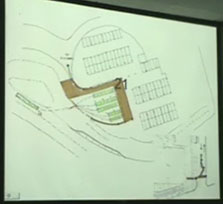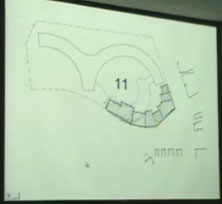Boasberg dismisses “irrelevancies” at Hilton hearing
Today’s HPRB meeting followed a familiar pattern, with Chairman Tersh Boasberg repeatedly cutting off witnesses for bringing up issues the Board can’t consider—even those that were mentioned in the staff report.
Boasberg started out the hearing by eliminating the building’s impact on the surrounding historic districts as a factor. Since the building is outside historic districts (though surrounded by five), Boasberg said, the board “can’t rule something too massive for a historic district the building is not in.”
The staff report drew fire from neighbors for suggesting that if HPRB rejected the plan, the Hilton might successfully appeal by arguing that the project has “special merit.” According to DC law,
Special merit means a plan or building having significant benefits to the District of Columbia or to the community by virtue of exemplary architecture, specific features of land planning, or social or other benefits having a high priority for community services.
The need for a more modern hotel containing larger exhibition space seems hardly a high priority for community services. If that’s special merit, then why not the development planned for the Cleveland Park Metro, whose opposition drove Boasberg’s preservation career and led to the creation of the Cleveland Park district? After all, mixed-use density around Metro should be a higher priority for the District of Columbia than one hotel among many.
But the “special merit” argument didn’t enter into the hearing either, as Boasberg dismissed it as irrelevant to the matter at hand. Nor did discussions of loading docks go much of anywhere, the topic that the staff report stretched to cover. Architect Volker Zinser presented alternative suggestions for the loading off the driveway loop on T Street, but Boasberg pushed him to abridge the loading discussion as another irrelevant topic.


Left: Alternative loading proposal by Volker Zinser. Right: Alternative building site proposal.
Comments about building closer to the street, on the other hand, were in order, and Zinser presented some other options for development along 19th and Florida that would give the corner a more residential feel and avoid exacerbating the “tower in a park” feel. But since preserving views of the landmark are paramount, as David Maloney said, buildings closer to the street could, if anything, block more of the view for those standing on Florida or T. Plus, as board member Andrew Aurbach pointed out, while he’d personally prefer a plan that “reopen[ed] the urban side on Florida and T to open the streetscape, that’s not the proposal” and that proposal is all they could evaluate.
Still, several other board members also criticized the sttreet-level elements of the plan while admitting they had few options. Maria Casarella said that the architects “inherit[ed] the fatal flaws” of the building, and that while the tower design is impressive, “below the plinth it’s really weak.” Robert Sonderman asked to see earlier concept sketches with the building starting closer to the street. Sonderman also recommended a more curvilinear approach to the corner entrance, which is one of the few silver linings in this design.
Ultimately, the board voted to accept the staff report, which recommended holding off approval pending agreement on the loading docks but generally assenting to the overall direction. It’s not clear how the Hilton and community could agree on a solution there that satisfy both, but one way or another, this project will most likely be built substantially as is.

